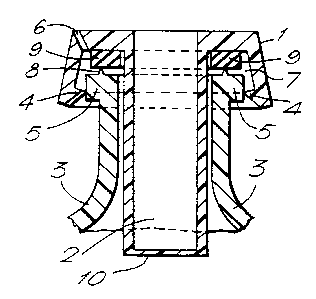Some of the information on this Web page has been provided by external sources. The Government of Canada is not responsible for the accuracy, reliability or currency of the information supplied by external sources. Users wishing to rely upon this information should consult directly with the source of the information. Content provided by external sources is not subject to official languages, privacy and accessibility requirements.
Any discrepancies in the text and image of the Claims and Abstract are due to differing posting times. Text of the Claims and Abstract are posted:
| (12) Patent: | (11) CA 2197230 |
|---|---|
| (54) English Title: | CONTAINER WITH CLOSURE CAP AND METHOD OF FILLING CONTAINERS WITHOUT GAS BUBBLES |
| (54) French Title: | CONTENANT AVEC BOUCHON ET METHODE DE REMPLISSAGE DES CONTENANTS SANS BULLES DE GAZ |
| Status: | Term Expired - Post Grant Beyond Limit |
| (51) International Patent Classification (IPC): |
|
|---|---|
| (72) Inventors : |
|
| (73) Owners : |
|
| (71) Applicants : |
|
| (74) Agent: | SMART & BIGGAR LP |
| (74) Associate agent: | |
| (45) Issued: | 2008-12-09 |
| (86) PCT Filing Date: | 1995-08-11 |
| (87) Open to Public Inspection: | 1996-02-29 |
| Examination requested: | 2002-08-08 |
| Availability of licence: | N/A |
| Dedicated to the Public: | N/A |
| (25) Language of filing: | English |
| Patent Cooperation Treaty (PCT): | Yes |
|---|---|
| (86) PCT Filing Number: | PCT/EP1995/003183 |
| (87) International Publication Number: | EP1995003183 |
| (85) National Entry: | 1997-02-10 |
| (30) Application Priority Data: | ||||||
|---|---|---|---|---|---|---|
|
A closure cap for sealing containers without gas bubbles
displaces some of the contents of the container when
fitted onto the neck of the container and at the same
time allows any trapped gas to escape through one or
more vents before the closure cap engages in the closure
position.
Un capuchon de fermeture qui permet de fermer des récipients sans gaz repousse une partie du contenu du récipient lorsqu'il est posé sur le col du récipient et permet en même temps au gaz contenu dans le récipient de s'échapper par une ou plusieurs ouvertures avant que le capuchon de fermeture ne soit verrouillé dans sa position de fermeture.
Note: Claims are shown in the official language in which they were submitted.
Note: Descriptions are shown in the official language in which they were submitted.

2024-08-01:As part of the Next Generation Patents (NGP) transition, the Canadian Patents Database (CPD) now contains a more detailed Event History, which replicates the Event Log of our new back-office solution.
Please note that "Inactive:" events refers to events no longer in use in our new back-office solution.
For a clearer understanding of the status of the application/patent presented on this page, the site Disclaimer , as well as the definitions for Patent , Event History , Maintenance Fee and Payment History should be consulted.
| Description | Date |
|---|---|
| Inactive: IPC expired | 2023-01-01 |
| Inactive: Expired (new Act pat) | 2015-08-11 |
| Grant by Issuance | 2008-12-09 |
| Inactive: Cover page published | 2008-12-08 |
| Inactive: Final fee received | 2008-09-22 |
| Pre-grant | 2008-09-22 |
| Notice of Allowance is Issued | 2008-04-28 |
| Letter Sent | 2008-04-28 |
| Notice of Allowance is Issued | 2008-04-28 |
| Inactive: Approved for allowance (AFA) | 2008-03-28 |
| Amendment Received - Voluntary Amendment | 2008-02-05 |
| Inactive: S.30(2) Rules - Examiner requisition | 2007-08-06 |
| Amendment Received - Voluntary Amendment | 2006-12-08 |
| Inactive: S.30(2) Rules - Examiner requisition | 2006-06-08 |
| Inactive: IPC from MCD | 2006-03-12 |
| Amendment Received - Voluntary Amendment | 2005-10-12 |
| Inactive: S.30(2) Rules - Examiner requisition | 2005-04-12 |
| Inactive: Application prosecuted on TS as of Log entry date | 2002-08-27 |
| Letter Sent | 2002-08-27 |
| Inactive: Status info is complete as of Log entry date | 2002-08-27 |
| Request for Examination Requirements Determined Compliant | 2002-08-08 |
| All Requirements for Examination Determined Compliant | 2002-08-08 |
| Letter Sent | 1997-12-15 |
| Inactive: Applicant deleted | 1997-08-13 |
| Inactive: Courtesy letter - Evidence | 1997-03-18 |
| Application Published (Open to Public Inspection) | 1996-02-29 |
There is no abandonment history.
The last payment was received on 2008-07-23
Note : If the full payment has not been received on or before the date indicated, a further fee may be required which may be one of the following
Patent fees are adjusted on the 1st of January every year. The amounts above are the current amounts if received by December 31 of the current year.
Please refer to the CIPO
Patent Fees
web page to see all current fee amounts.
Note: Records showing the ownership history in alphabetical order.
| Current Owners on Record |
|---|
| BOEHRINGER INGELHEIM KG |
| Past Owners on Record |
|---|
| BERNHARD FREUND |
| HEINRICH KLADDERS |
| JOACHIM EICHER |
| JOACHIM JAEGER |
| WULF BACHTLER |